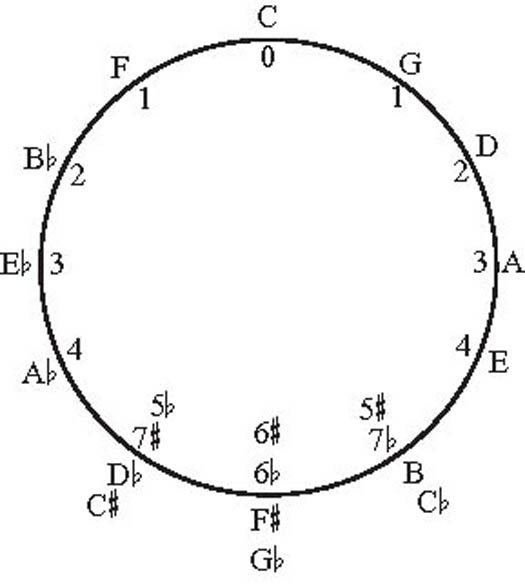Just to clarify that some pretty important terminology isn't going over your head:

The "Tonic" is the base note of the key. If the key is C (like in the image), then the tonic is C.
The "Dominant" is the 5th up from the topic, i.e., the 5th note of the key. Again using C as an example, G is the Dominant.
The "Sub-Dominant" is a 5th
down from the Tonic. In the case of C, you can see that this is F, so we can deduce that it is the 4th note of the scale.
The same logic follows for the mediant and the submedient, the 3rd (E) and 6th (A) notes of the scale respectively.
When Rubato talked about Sub-dominant and Dominant keys being closely related to the Tonic, he meant that they have almost all their notes in common. Indeed, the only difference between C and F(Sub-Dom) is a B natural in C and a B flat in F, and the only difference between C and G (Dom) is an F in C and an F sharp in G. Every key has two other keys that it only differs from by one note, which just so happen to be the dominant and sub-dominants of that key. This can be easily seen in what is known as "The Circle of Fifths"

As you can see in the above. If you go a fifth up or a fifth down, you get another closely related key. The beauty of it is that you can go the whole way around in either direction and get back to where you started. If that doesn't seem to make immediate sense, try it out - it's quite satisfying to work the whole way around it.
To relate all this to what Rubato said: Because the keys of C and G are so similar (and F, incidentally), we look for pointers to figure out which key it actually is - namely the one note they differ on; F sharp (or a B flat for F).
As rubato showed, the first chord rules out none of them - they all contain A C and E, the A minor chord. the Second chord has G B
natural and D, which rules out the F (because if it were in F we would expect a chord containing B flat), Finally, the Third chord is D F
sharp A, which leads us right in the direction of G, as we know it's the only one of the three which fits those notes.
Does that make sense?
Of course, this is just a guideline for finding the key - many pieces may not even bother with having a central key, and might shift between keys at will - though generally they tend to modulate (change key) to a related chord - either one up or down the circle of fifths, or possibly to the Relative Minor/Major (the Minor.Major key that shares all the same notes - each major key has one (and vice versa obviously), it's A minor for C if you want to check).
The other indicator Rubato mentioned was the chords themselves. Within a Key, each Chord has a number, defined by where it sits on the scale of the key you are in. f.ex., G is the 5th note in C, so the G chord in C is denoted V, F is IV, E is III etc. etc. Because chord progressions are so important for the tone of a piece, it means that it's easy to document the "Common" chord progressions, and the chords that turn up most often in a piece. For example, III is a chord that doesn't tend to turn up that much outside of Jazz, from what I remember (because it contains 3/5/7 of the key, which is a distinctly jazzy sound). ii (some of the chords (ii, vi, vii) are written in lower case, to denote the minor-key aspects of the chord - try playing them and you'll see why) only really ever comes up as part of a sequence of chords, because it sounds odd on its own, V and IV are waay more common, especially in Pop/Rock, and are used in tandem as a cadence (the "end" of a phrase, sort of like musical punctuation) all the time. There are lots of cadences, some more widely used than others. Each one has its own unique sound - it might be a full stop, or a comma, or in the case of the Interrupted Cadence (V-vi), like someone has gone over a bump in a car and you're waiting for it to come back down. There's an old joke about how Mozart's wife used to get him out of bed in the morning by playing an interrupted cadence. He couldn't leave it like that, so he'd have to come downstairs and resolve it :P Whether or not that happened, I have no idea, and it's probably been used with pretty much every famous composer as the subject at some point...
I hope that that didn't confuse you further, and that if there was anything that wasn't making sense thus far, that this went some way to explaining it. If you already knew all that beforehand, well, good for you :P








 Linear Mode
Linear Mode
